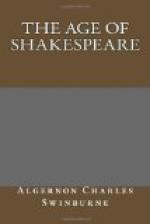Thou sallow picture of my poisoned
love,
My study’s ornament, thou
shell of death,
Once the bright face of my betrothed
lady,
When life and beauty naturally filled
out
These ragged imperfections;
When two heaven-pointed diamonds
were set
In these unsightly rings;—then
’twas a face
So far beyond the artificial shine
Of any woman’s bought complexion
That the uprightest man (if such
there be,
That sin but seven times a day)
broke custom
And made up eight with looking after
her.
The very fall of the verse has a sort of fierce and savage pathos in the note of it; a cadence which comes nearer to the echo of such laughter as utters the cry of an anguish too deep for weeping and wailing, for curses or for prayers, than anything in dramatic poetry outside the part of Hamlet. It would be a conjecture not less plausible than futile, though perhaps not less futile than plausible, which should suggest that the influence of Shakespeare’s Hamlet may be responsible for the creation of Tourneur’s Vindice, and the influence of Tourneur’s Vindice for the creation of Shakespeare’s Timon. It is a certainty indisputable except by the blatant audacity of immedicable ignorance that the only poet to whose manner and style the style and manner of Cyril Tourneur can reasonably be said to bear any considerable resemblance is William Shakespeare. The more curt and abrupt style of Webster is equally unlike the general style of either. And if, as his first




